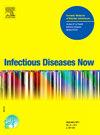预防吸入性肺炎复发
IF 2.2
4区 医学
Q2 INFECTIOUS DISEASES
引用次数: 0
摘要
吸入性肺炎发生在有记录的误吸后或有误吸危险因素的患者中,提示病原体可能通过口咽入口进入。旨在防止再次发生的战略的基础是确定危险因素、修改危险因素和执行适当的纠正措施。方法对2000-2025年有关吸入性肺炎预防的文献进行综合分析。结果必须重新评估可能加重吞咽障碍的治疗方法,特别是抗胆碱能药物、镇静剂和精神药物。没有一种治疗方法对直接预防吸入性肺炎有显著效果。营养需求可以通过肠内营养来满足,但它会增加口腔细菌定植、口腔生物膜厚度和肌肉无力。一系列措施(认知障碍患者半坐位或肠内营养、言语治疗、康复、消除牙生物膜)对预防吸入性肺炎有显著效果。尽管对生活质量和营养摄入有潜在影响,但调整食物质地和增稠液体是正在考虑的降低风险的措施。结论老年人肺炎发作后应进行多学科评估,以确定病原体的进入途径,并制定预防复发的计划。未来的研究将需要在各种措施中确定优先事项,以优化管理战略。本文章由计算机程序翻译,如有差异,请以英文原文为准。
Prevention of aspiration pneumonia recurrences
Context
Aspiration pneumonia occurs after a documented aspiration or in patients with aspiration risk factors, suggesting a potential oropharyngeal portal of entry for the responsible pathogens. Strategies aimed at preventing recurrences are based on the identification of risk factors, their modification, and the implementation of appropriate corrective measures.
Methods
A comprehensive review of the literature (2000–2025) on the prevention of aspiration pneumonia was conducted.
Results
Treatments likely to exacerbate swallowing disorders must be reassessed, particularly anticholinergics, sedatives, and psychotropic drugs. No treatment was significantly effective in directly preventing aspiration pneumonia. Nutritional requirements are met using enteral nutrition, but it increases oral bacterial colonization, oral biofilm thickness, and muscle weakness. A series of measures (semi-sitting positioning in patients with impaired awareness or enteral nutrition, speech therapy, rehabilitation, and elimination of dental biofilm) were significantly effective in preventing aspiration pneumonia. Adapting food texture and thickening liquids are measures being considered to reduce the risks, despite the potential impact on the quality of life and on nutritional intake.
Conclusion
A multidisciplinary assessment is recommended after an episode of pneumonia in the elderly to identify the pathogen’s route of entry and to establish a plan to prevent recurrences. Future research will need to determine priorities among the various measures proposed to optimize management strategies.
求助全文
通过发布文献求助,成功后即可免费获取论文全文。
去求助
来源期刊

Infectious diseases now
Medicine-Infectious Diseases
CiteScore
7.10
自引率
2.90%
发文量
116
审稿时长
40 days
 求助内容:
求助内容: 应助结果提醒方式:
应助结果提醒方式:


